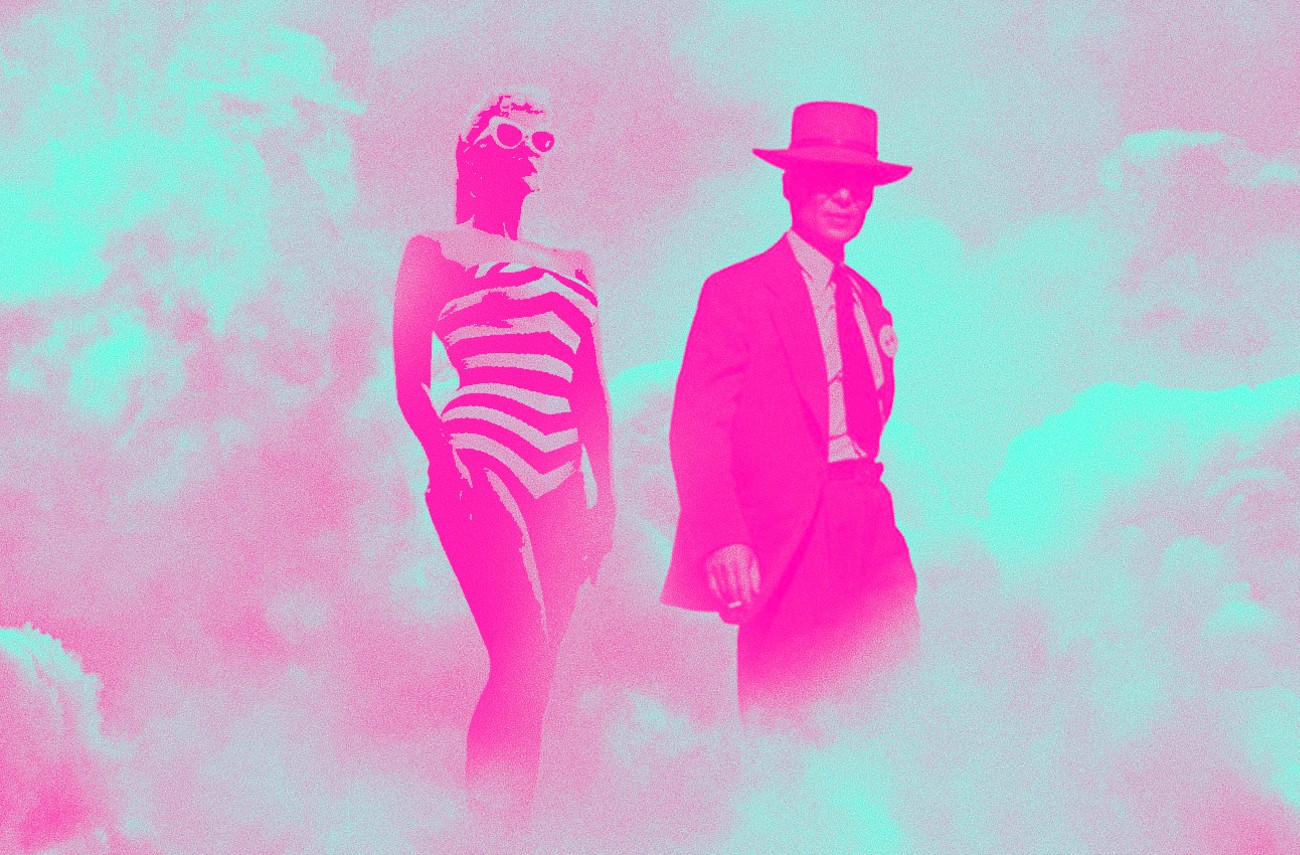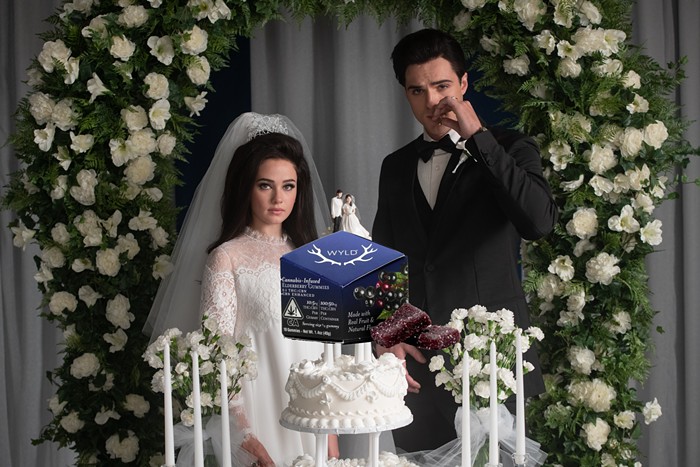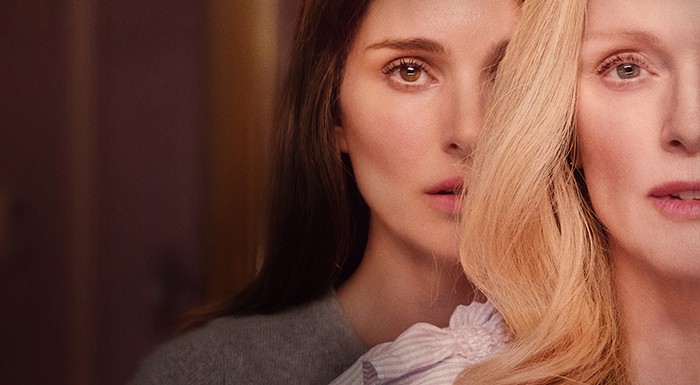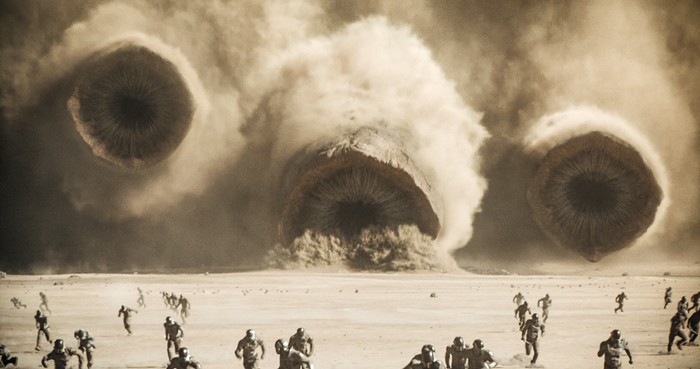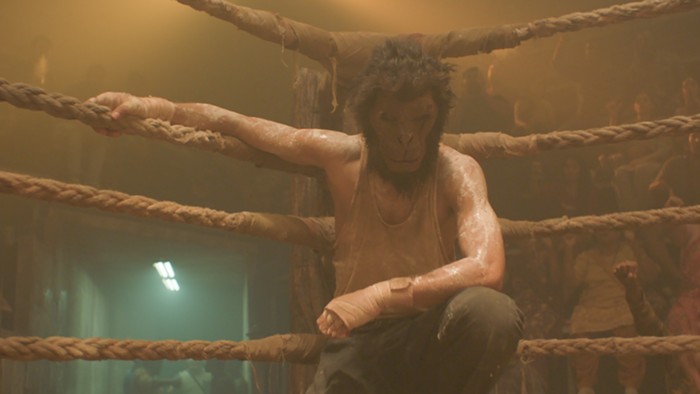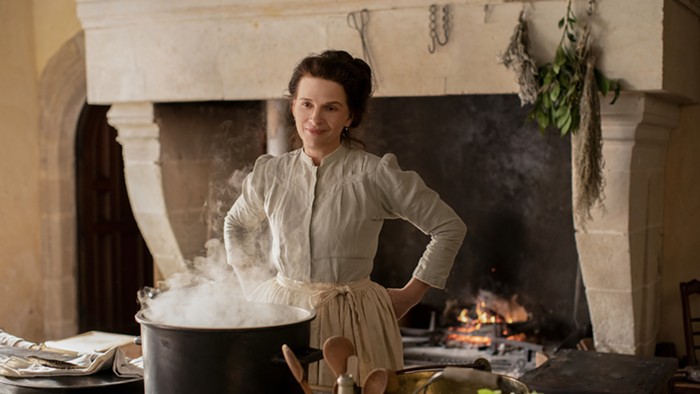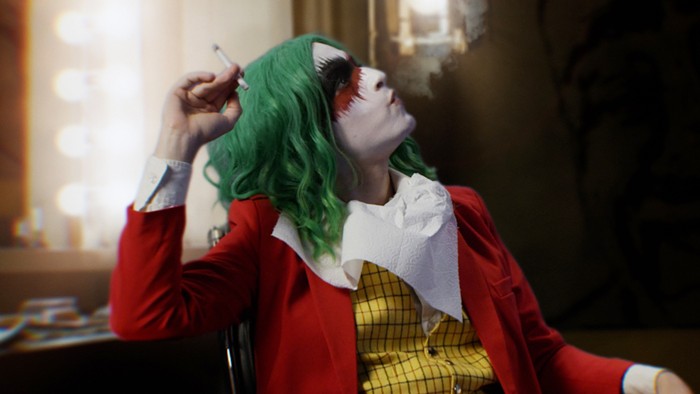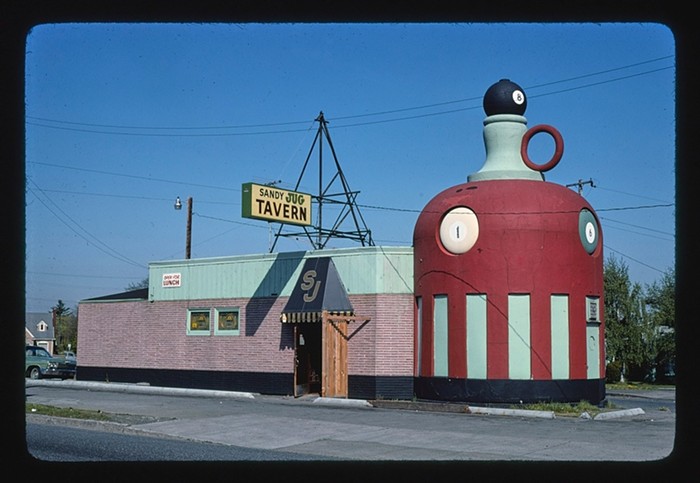It's natural to find (or even invent) patterns when major media properties or historical moments collide. They wind up inextricably linked: Think of Dark Side of the Moon as synced with Wizard of Oz, or a Bagel Bites commercial that rewrote a country standard for a new snacking generation, or that Coup album cover with an image of burning World Trade Center towers that was scheduled to launch in mid-September 2001. Stuff like that.
This weekend, for whatever reason, movie studios have chosen to debut Oppenheimer and Barbie at the same time. If these films had stayed out of each other's way, we might have never connected their common themes of controversial, even damaging man-made creations from the middle of the 20th century. But here we are, coining phrases like Barbieheimer / Barbenheimer / Oppenbarbie and printing custom T-shirts that bathe phrases like "death, the destroyer of worlds" in pink, glittering fonts. These films will be forever joined in the history books for the bullshit reason of a crowded summer film schedule.
Thus, we have no choice but to definitively science out which of these films is better via the below rubric.
Best Reframing of an Iffy History
It's one thing for director and co-writer Greta Gerwig to rip and tear at Barbie's seams as a brand; it's another for her to transparently clue viewers into the marketing shamelessness. Barbie is a two-hour commercial for dolls, and its characters are forced to reckon with this while also grappling with their existence as both concepts and, to a certain extent, real women. All the while, the film suggests the utopian ideal that Barbie's creators had hoped for—that they'd wanted to give little girls dreams of a more independent life as grown-up women—and bravely juxtaposes that with the failed promises of second-wave feminism. All while being a hilarious film where grown men argue about "beaching each other off."
Oppenheimer opens with a much different tone: The origin of a man swept up by a new era of early 20th-century discovery. Science was advancing rapidly for the titular Oppenheimer, and director-writer Christopher Nolan follows actor Cillian Murphy through a relatable, momentum-driven journey through idyllic universities around the world and chance encounters with brilliant minds. The man who went on to helm the atom bomb had his own explosion to make sense of, and Oppenheimer smartly anchors its story with a deeply human instinct to master one's surroundings, even if that urge might lead to ruin.
Winner: Barbie
Best Portrayal the Legal System
The character of Lawyer Barbie says the following during an early sequence: "In our investments, money is not speech, and corporations have no free speech rights to begin with. So any claim on their part to be exercising a right is just their attempt to turn our democracy into a plutocracy. This makes me emotional, and I'm expressing it. I have no difficulty holding both logic and feeling at the same time, and it does not diminish my powers. It expands them." For context, this is not a sarcastic send-up about Barbies being inherently dumb, but rather a whimsically framed Barbieland utopia where empowered women went to school, achieved their dreams, and know their shit. We also get to see President Barbie—absolutely nailed by Issa Rae, sneaking depth into her quip-heavy portrayal—along with a whole-ass Barbie council that votes on stuff, then cheers and dances to fantastic pop music.
After a rollicking start, Oppenheimer's third hour hides in a series of small, stuffy rooms. This portion of the film obsesses over a legal process that famously dragged the titular man's name in the mud following his post-war popularity and subsequent anti-bomb campaigning. Security clearances, Communist allegations, surprise witnesses, exasperated defense attorneys. It's a whiplash-inducing slam on the brakes after the film's first two hours of gorgeous scenery and armrest-gripping anxiety.
Winner: Barbie
Best Superfluous Women
Barbie wears its source material's checkered history as a source of moviegoing joy. Cameos of bizarre, yep-they-really-existed toys deliver hilarious, pointed skewering of the brand's most dumbass attempts to win mindshare over the years, and they're great punctuation for the film's carefully choreographed stream of sight gags. (I won't spoil the best cameos here, other than to say the end credits recount any that you might have missed or didn't believe were real.)
Oppenheimer somehow can't figure out how to win this category despite having a full three hours of runtime to make space for compelling women. Florence Pugh's portrayal of psychiatrist Jean Tatlock is the biggest loser here, as she only shows up to check historical boxes for the film's main man: He was a womanizer; he was horny about at least one card-carrying Communist; and he had regrets about how their affair ended. You get to see Pugh look sad and take her shirt off a few times.
Winner: Barbie
Best Ken-ergy
One of my favorite things about Barbie is its consistent framing of male fragility in a funhouse mirror. The film stars many "Ken"s, all second fiddle to the film's many Barbies (with the exception of Michael Cera as Allen, who does a great job playing the character of Michael Cera), but Ryan Gosling is the most Ken-etic of them all. While his character enjoys an arc of sorts, his Ken sticks to a formula of overconfidence, insecurity, distractibility, irrationality, and hypersensitivity—yet somehow Gosling makes this mess of a plasticky man likable. He nails the timing for non-verbal pauses and cartoony gestures that would look foolish in other actors' rigid-toy hands.
To its credit, Oppenheimer revolves around its own version of Ken-ergy: a chorus of men strapped to the inevitability of an atomic bomb, albeit each in their own relatably naive ways. Matt Damon is a likable hardass of a Lieutenant General, splitting his focus between blind patriotism and sometimes equally blind faith in his physicist cohorts. Robert Downey Jr. slicks his hair back and convincingly transforms into a compelling shitstain of a McCarthy-allied politician, eager to leap off Oppenheimer's radiation-singed reputation for his own benefit. And Cillian Murphy conveys not only the utter torture of his character's existence but also betrays his most unsavory traits in compelling fashion, making us excitedly wonder while watching, "How does this man live with the evil he hath wrought?"
Winner: Tie
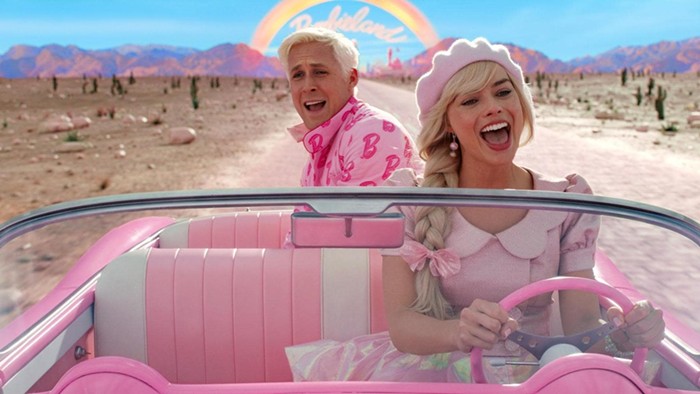
Best Fantasy Land
Barbie's runtime is split halfway between the real world and Barbieland, and the latter is absolutely dazzling. Every car and vehicle inside the film's toy reality is perfectly plasticky, and they're sometimes driven in front of clever 2D backdrops for humorous effect. Every interior decoration is seemingly ripped from a real-life Barbie playset, including intentionally flat or impractical pieces, and the props have been rebuilt to look like massive toys in ways that rival the best toy-humor moments from the CGI-filled LEGO Movie.
At certain angles, the Los Alamos rebuilt for Oppenheimer looks like a Wes Anderson set, mostly because Anderson loves mid-century throwbacks. But the set designers here understand how to jump into and out of every corner of a massive bomb-building space, not only to frame the infamous bomb in a gorgeous and haunting nighttime sequence but to also move nervous scientists and engineers around a barracks in clever ways. One striking scene has Oppenheimer walk from a black void into an eerily lit protest against military weaponry, and it's as memorable as both the massive atomic explosion in the film's center and the deafening, jingoistic roar that haunts Oppenheimer soon after it explodes.
Coincidentally, both films revolve around the consequences of a false utopia. The inhabitants of Barbieland and Los Alamos alike are defined by their relationship with invented rules and structures. Inside of Barbieland, outcasts and Kens simmer uneasily beneath the veneer of daily slumber parties and choreographed dances, and this tenuous relationship fuels a lot of the comedy. Meanwhile, the birthplace of the atom bomb is a huge piece of its assembly's puzzle, and Nolan makes sure Oppenheimer viewers see how its enormity guides the people who operate somewhat hopelessly inside of it.
Winner: Oppenheimer
Best Horses
Barbie and Oppenheimer each feature lots of horsies, which I only point out because I noticed the ones in Oppenheimer a ton after seeing Barbie first. Barbie's horses are better. Horse combs sold separately.
Winner: Barbie
Best Impact on the World
How can a war movie freshly convey the folly of manmade conflict and arms races? Does Oppenheimer solely exist because pioneering filmmakers of the '60s and '70s didn't forever end war with their grim portrayals? For the range of emotions Nolan's latest film brought out, elicited by masterful handling of sight and sound (and, goodness, its 70mm presentation is a beaut), I didn't leave believing he had a good answer to the movie's purpose or point. Which, ugh, might be the point. Near the film's conclusion, one character outright describes Oppenheimer as a man with the same lack of clear purpose and understanding as this film. Which is to say: If you're looking for the feel-bad film of the summer, one that reinforces the likely doom when horny, shortsighted men follow their starry-eyed ambitions into massive New Mexico plains to blow the world up without thinking things through, Oppenheimer is for you.
For a "toy" movie, Barbie manages to say a lot. Gerwig frames her film's central toy as an idealized form, an idol, by which a society might model its values. In this case, those values are superficial and commercial, and we get to see multiple women in the film try and live up to those values, particularly Margot Robbie's character of "Stereotypical Barbie." This is a comedy through and through, and Robbie's coming-of-age approach to the character, leading her to a certain kind of womanhood, is defined by a knack for surprise. Her retorts and facial tics are the crucial cracks in the film's series of articulately built Dreamhouses, suggesting massive changes to come while focusing on laughs and punchlines within each moment. Eventually, when she and fellow lead America Ferrera eventually shift into 100% earnest territory, the result lands like a massive atom bomb, breaking the entire plasticky shell apart in a way that feels earned, not overwrought. You will leave Barbie rethinking what a toy that defined a prior generation might do for current conversations about womanhood in the West. However, you will also leave with a potential desire to buy a doll to place on your own shelf, as its own idol, where you might assign it any of the values mentioned in the film. And then buy it outfits.
Winner: Barbie
CAN'T GET ENOUGH BARBENHEIMER? Well, luckily there's a full scale Barbie publicity cycle currently covering the Earth. Check out Everout's list of Where to Celebrate the Barbie Movie Premiere in Style in Portland, which includes the indie movie houses in town bringing you all the Oppenbarbie you can BarbieHeimer.
